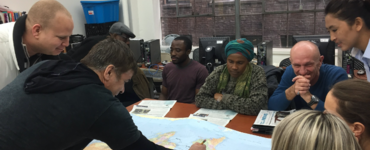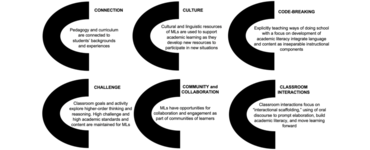In a “voices from the field” essay, Dr. Jenna Cushing-Leubner reflects on the question, “What can racial equity look like to the teaching of English to racialized bilingual youth?” She describes the efforts made by multilingual youth labeled “long-term English learners” and “heritage language learners” through ethnic studies and youth participatory action research projects to communicate to language teachers what they need to know and be able/willing to do. In this call to action, she shares these findings from almost a decade of work with multilingual youth of color and their language teachers, and suggests resources for teachers invested in anti-racist and anti-biased English language teaching.
Key words: sustainable multilingualism, ethnic studies, racial equity, long-term English learners, heritage language
One spring day in 2012, twenty language teachers and administrators gathered for a day of professional development in a South Minneapolis classroom. They gathered almost exactly two miles from what would become George Floyd Square and the George Floyd Autonomous Zone in the wake of years of violence, surveillance, detention, and deportation experienced by Black, Indigenous, and non-Black/Indigenous People of Color (BIPOC), which came to a head in the summer of 2020 when George Floyd was killed by Minneapolis police in the early months of COVID-19’s stay-at-home orders and economic destabilizations. The professional development was designed and facilitated by a group of multilingual Latinx high school students who had all experienced some form of ESL. Some had spent so many years in ESL and English-only U.S. schooling that they had become labeled “long-term English learners”—a term that critical language educators argue doubles down on the idea that multilingual children of color either don’t want to or can’t learn English, and therefore don’t want to or can’t do intellectual work in school, which is done primarily through English (Flores et al., 2015; Menken & Kleyn, 2009; Tse, 2001).
The professional development that day grew out of a process called youth participatory action research (Cammarota & Fine, 2010; Mirra et al., 2015; Youth Activism Project, 2018). Youth had been asking:
- What would it take to have the kind of education that we deserve?
- What do our teachers need to know, be able, and be willing to do to teach us in ways we deserve?
Race-conscious language education
Youth were part of a Spanish Heritage Language class, where they had spent two years in intra-ethnic studies classes within the context of a world language course. Through these ethnic studies language classes, youth disentangled themselves from negative narratives and images about themselves, their families, and their communities. They explored relationships of colonization and systemic racism with language in education and school curricula.
They were reclaiming their home languages. They were trying to reconnect with family members and strengthen familial bonds. Through those reconnections, they were trying to recognize their families’ and communities’ ways of knowing and doing things, which had been frayed or severed through intergenerational separations, caused in part by home language removal and replacement (first by Spanish and later by English). And they were studying examples of movements to fight for economic, educational, and sociopolitical justice led by coalitions of multilingual and multidialectal BIPOC communities.
From their ethnic studies courses and through doing youth participatory action research, they knew that systemic racism had shaped their educational experiences as multilingual people of color. They knew that, in the eyes of schools, they (and other multilingual and multidialectal BIPOC youth) were labeled and treated as problems. They were viewed as (long-term) English learners who were “at risk” and in need of remediation (Flores et al., 2015); potentially dangerous and untrustworthy, and in need of surveillance and control (Giroux, 2009); and ultimately disposable (Darder, 2006; Rocco, 2016).
Through their schooling experiences (Au et al., 2016; Spring, 2016), they were learning lessons about the denigration and erasure of Indigenous peoples. They were learning lessons about the denigration and vilification of people of African descent—particularly African Americans and Afro-Latinx people with histories of enslavement across the Americas. They were learning lessons about the supposed superiority and natural dominance of people of European descent. And they knew that these lessons were roiling around themselves and their loved ones, as people of color viewed as perpetual outsiders in a country dominated by English, white supremacy and its privileges, removal of Indigenous peoples and relationships, and anti-blackness.
What can racial equity in English language education look like?
This group of youth—like so many groups of multilingual youth of color taught by the language teachers we have worked with in the years that followed—decided to use their multilingualism to push for changes. First, they developed content-specific curriculum suggestions and presented them to teachers, administrators, students, and district officials. Next, they went to elementary schools to teach younger children. Finally, they designed professional development for pre-service and practicing language teachers—who they viewed as their most immediate and potential advocates for educational change.
As multilingual BIPOC youth, they were not just interested in linguistic changes to schools. They were insisting on raciolinguistic (Alim et al., 2016; Flores & Rosa, 2015) transformation—transformations that reflect intersections of language, race, and ethnolinguistic funds of knowledge. This article’s call to action consists of their calls to action. If we are looking for racial equity in English language teaching, here is what that involves, and what it asks of us:
1. Approach English language development as a component of sustaining existing multilingualism
As a field, and in the majority of ESL programming, our primary focus is on English language development only. This puts English language development at the expense of the loss (by removal and replacement) of home languages (Skutknabb-Kangas, 2019).
The ESL teaching field (“TESOL”) is for the teaching of English to speakers of other languages. This means that our goal should be in sustaining multilingualism and culturally sustaining pedagogies (Alim & Paris, 2017), with English becoming an additional language—not the primary, dominant, or only language.
2. Take identities, relationships, and power seriously
Know yourself as a person and an educator. Be able to name the implicit and explicit messages that have shaped your views of power systems, languages, and racialized people. Your students may not know you for your personal experiences. You also represent roles in larger systems of power. Regardless of our racial and ethnolinguistic identities, as English language teachers, we have to prove that we are committed to racial and linguistic justice.
Accompany your students in fighting for changes they believe in. Once they identify what changes need to happen, use organizing practices like power mapping as instructional tools for meaningful language. Change-making spans content areas. Learn language by participating in transformation (Advocates for Youth, 2019; Cushing-Leubner & Eik, 2018).
3. Insist on, and leverage support for, more multilingual teachers of color
Multilingual BIPOC children seldom have multilingual BIPOC teachers. Just because we have multilingual BIPOC teachers, doesn’t mean our teacher education and ongoing professional development opportunities have been supportive of how to teach in translingual1 ways, in ways that are community-driven, or in ways that are informed by racial consciousness and community funds of knowledge. This means that our teacher preparation programs and our school environments are not typically nurturing of developing and strengthening these teaching practices.
If you are a multilingual BIPOC teacher, get connected with personal and professional networks that will support you and sustain your teaching in ways that will allow your students to get access to the benefits of multilingualism from a multilingual teacher. If you are a white and/or English-dominant teacher, advocate at your school and district-level for the hiring of multilingual BIPOC teachers and for professional development support explicitly connected to multilingual, culturally sustaining teaching and instructional materials.
4. Ensure access to intra-ethnic studies
Access to ethnic studies courses (Tolteka Cuauhtin et al., 2019) positively impacts academic success and social-emotional protective factors (Cabrera et al., 2014; Dee & Penner, 2017; Sleeter, 2011; Sleeter & Zavala, 2020). Efforts to offer ethnic studies in schools are not new. When ethnic studies are available, they are typically offered as elective courses. However, English language development and co-curricular language and literacy remediation coursework limits access to elective courses for multilingual BIPOC students labeled English learners (Estrada, 2014).
Advocate to your school, district, and the state for the inclusion of ethnic studies in the mainstream curriculum and as special interest electives. Inventory your own teaching—how are you providing ethnic studies content and pedagogies (Tolteka Cuauhtin et al., 2019) as an English language teacher? If you do not have the background knowledge or teaching practices for ethnic studies, seek professional development and advocate for paid positions, teacher preparation, and licensure support for community-educators who do.
5. Teach how race, racial formation, and systemic racism works in the United States
We must teach about how race works in the United States, how new immigrants and immigrant communities experience racialization, and how messages of white superiority and anti-blackness are integral to the Americanization process. It’s not helpful to pretend that race works in simple ways across communities of color, particularly with recent experiences with immigration. Multilingual BIPOC children deserve to understand how racialization is at play in their own experiences and across their communities. And they deserve to have the tools of racial literacy and reckoning with the violence and harms of anti-blackness and white supremacy. If you do not feel knowledgeable or comfortable teaching about this and the particular ways racism plays out in relationship to your students’ communities, this is an area for explicit and intentional personal and professional development. Advocate for paid positions, teacher preparation, and licensure support for multilingual BIPOC community-educators who do.
Coda
The United States is no stranger to racial inequities or its violences. Recognizing systemic racism and its everyday enactments is not enough. The calls to action shared here are about interruption, dismantlement, and creating different ways of doing things all together. Working against racism as individual actors can shake up our corners of racist systems, but on their own they will never result in systemic transformation and lasting change. Luckily, working alone is a choice that doesn’t need to be made. These calls to action ask for collective efforts, following the directives of BIPOC-led strategies that have been developed out of engaging in struggles for liberation and freedom for centuries. And we each have a place in this project.
Suggested resources (to start)
Books
- En Comunidad: Lessons for Centering the Voices and Experiences of Bilingual Latinx Students (Carla España and Luz Yadira Herrera)
https://www.heinemann.com/products/e11248.aspx
- Dear My Teacher: Letters of Joy, Pain, and Triumph From Today’s Teenage Hmong Students (Pang Yang and Mike H. Vang, Eds.)
https://herpublisher.com/products/dear-my-teacher-letters-of-joy-pain-and-triumph-from-today-s-teenage-hmong-students
- Rethinking Bilingual Education: Welcoming Home Languages in Our Classrooms (Elizabeth Barbian, Grace Gonzales, and Pilar Mejia, Eds)
https://rethinkingschools.org/books/rethinking-bilingual-education/
- Rethinking Ethnic Studies (Tolteka Cuahtin, Miguel Zavala, Christine Sleeter, Wayne Au, Eds.)
https://rethinkingschools.org/books/rethinking-ethnic-studies/
Regional Organizations
- Coalition to Increase Teachers of Color and American Indian Teachers in Minnesota
https://www.tocaimn.com/
- Education for Liberation Network – Minnesota Chapter
https://www.tocaimn.com/
- Education Minnesota’s Educator of Color Forums
https://www.educationminnesota.org/advocacy/Social-justice/Forums
- League of Latinx Educators
https://sites.google.com/view/leagueoflatinxeducators/
- Coalition of Hmong Language Educators
www.hmonglanguageresourcehub.com;
https://www.youtube.com/watch?v=iLhVbl41F8E
Podcasts
- “Nice White Parents”
https://art19.com/shows/nice-white-parents
- “School Colors”
https://www.schoolcolorspodcast.com/
- “Seeing White”
https://www.sceneonradio.org/seeing-white/
Teaching Resources
- CUNY-NYSIEB’s translanguaging resource hub (teaching guides, webinars, research reports, book lists, and videos)
https://www.schoolcolorspodcast.com/
- “Asian American Racial Justice Toolkit”
https://www.asianamtoolkit.org/the-toolkit
- Teaching Tolerance’s Social Justice Standards – A Framework for Anti-Bias Education
https://www.tolerance.org/frameworks/social-justice-standards
Notes
- The term “translingual” refers to how languages mix, mesh, merge, and are created in the natural world, where people come into contact and create new ways of using languages to communicate. The term “translanguaging” refers to the use of these translingual practices in educational environments for teaching and learning.
References
Advocates for Youth (2019). Youth activist toolkit. Retrievable from: https://www.advocatesforyouth.org/wpcontent/uploads/storage//advfy/documents/Activist_Toolkit/activisttoolkit.pdf
Alim, H. S., & Paris, D. (2017). Culturally sustaining pedagogies: Teaching and learning for justice in a changing world. Teachers College Press.
Alim, H.S., Rickford, J.R., & Ball, A.F. (2016). Raciolinguistics: How language shapes our ideas about race. Oxford University Press.
Au, W., Brown, A. L., & Calderón, D. (2016). Reclaiming the multicultural roots of US curriculum: Communities of color and official knowledge in education. Teachers College Press.
Cabrera, N. L., Milem, J. F., Jaquette, O., & Marx, R. W. (2014). Missing the (student achievement) forest for all the (political) trees: Empiricism and the Mexican American studies controversy in Tucson. American Educational Research Journal, 51(6), 1084-1118.
Cammarota, J., & Fine, M. (Eds.). (2010). Revolutionizing education: Youth participatory action research in motion. Routledge.
Cushing-Leubner, J., & Eik, J. (2018). Our wild tongues: Language justice and youth research. In J. Ayala, J. Cammarota, M. Rivera, L. F. Rodríguez, M. Berta-Ávila, & M. E Torre (Eds.), PAR entremundo: A pedagogy of the Américas (pp 117-133). Peter Lang.
Darder, A. (2006). Latino youth: Pedagogy, praxis, and policy. Latino Studies, 4(3), 302-304. https://doi.org/10.1057/palgrave.lst.8600205
Dee, T. S., & Penner, E. K. (2017). The causal effects of cultural relevance: Evidence from an ethnic studies curriculum. American Educational Research Journal, 54(1), 127-166. https://doi.org/10.3102/0002831216677002
Estrada, P. (2014). English learner curricular streams in four middle schools: Triage in the trenches. The Urban Review, 46(4), 535-573. https://doi.org/10.1007/s11256-014-0276-7
Flores, N., Kleyn, T., & Menken, K. (2015). Looking holistically in a climate of partiality: Identities of students labeled long-term English language learners. Journal of Language, Identity & Education, 14(2), 113-132. https://doi.org/10.1080/15348458.2015.1019787
Flores, N., & Rosa, J. (2015). Undoing appropriateness: Raciolinguistic ideologies and language diversity in education. Harvard Educational Review, 85(2), 149-171. http://dx.doi.org/10.17763/0017-8055.85.2.149
Giroux, H. (2009). Youth in a suspect society: Democracy or disposability? Springer.
Menken, K. & Kleyn, T. (2009). The difficult road for long-term English learners. Educational Leadership, 66(7), 26-29.
Mirra, N., Garcia, A., & Morrell, E. (2015). Doing youth participatory action research: Transforming inquiry with researchers, educators, and students. Routledge.
Rocco, R. (2016). Disposable subjects: The racial normativity of neoliberalism and Latino immigrants. Latino Studies, 14(1), 99-117. https://doi.org/10.1057/lst.2015.51
Skutknabb-Kangas, T. (2019). Imagining multilingual TESOL revisited: Where are we now? Presented at TESOL International Conference 2019, Atlanta, GA. Retrievable from: https://www.youtube.com/watch?v=lG-bW7oWErE
Sleeter, C. E. (2011). The academic and social value of ethnic studies. National Education Association. Retrievable from: https://vtechworks.lib.vt.edu/bitstream/handle/10919/84024/AcademicSocialValue.pdf
Sleeter, C. E., & Zavala, M. (2020). Transformative ethnic studies in schools: Curriculum, pedagogy, and research. Teachers College Press.
Spring, J. (2016). Deculturalization and the struggle for equality: A brief history of the education of dominated cultures in the United States. Routledge.
Tolteka Cuauhtin, R., Zavala, M., Sleeter, C., & Au, W. (2019). Rethinking ethnic studies. Rethinking Schools. https://rethinkingschools.org/books/rethinking-ethnic-studies/
Tse, L. (2001). Why don’t they learn English? Separating fact from fallacy in the U.S. language debate. New York: Teachers College Press. Linked review accessible online: https://www.hepg.org/her-home/issues/harvard-educational-review-volume-72-issue-3/herbooknote/why-don%E2%80%99t-they-learn-english-_54
Youth Activism Project (2018). What is youth participatory action research? A where-to-start guide for youth, educators, and youth workers around the world. https://youthactivismproject.org/wp-content/uploads/2018/05/Youth-Activism-Project-YPAR-Guide.pdf









